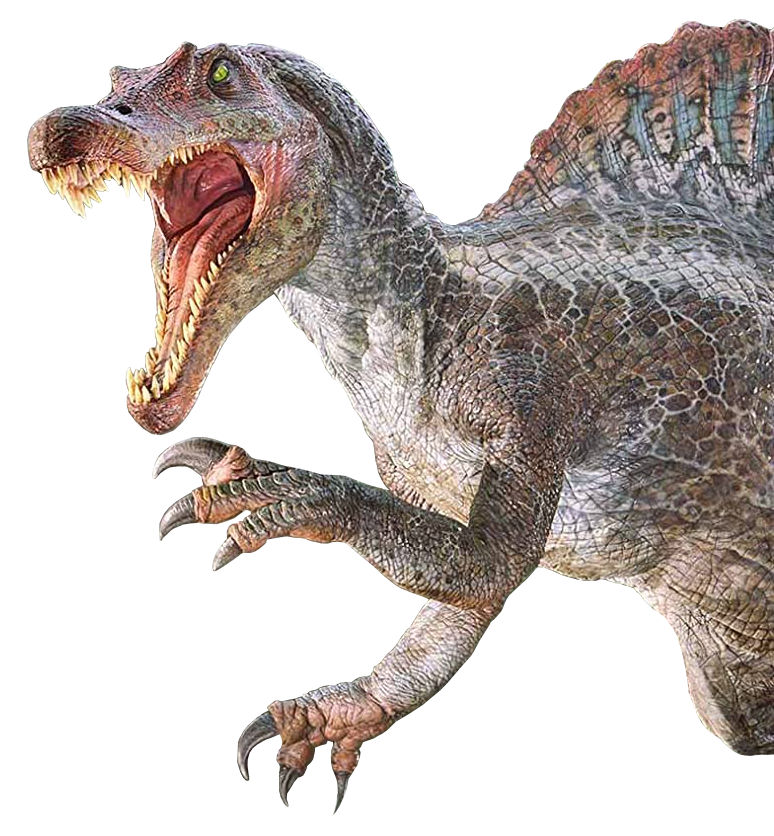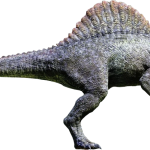Jurassic World Dominion Spinosaurus
“Okay, even I have to admit that this next dinosaur is impressive. The Spinosaurus is perhaps the largest of carnivores. Of course, I’ll never get close enough to one to see for myself. But that’s why I have you.”
— Cabot Finch

Spinosaurus (meaning “spined lizard”) is an extinct genus of spinosaurid theropod dinosaur that existed in what is now North Africa during the Cretaceous period. Spinosaurus is the longest of all known carnivorous dinosaurs, even longer than Carcharodontosaurus, Giganotosaurus, and Tyrannosaurus rex at a length of 54-55 feet.
Its most distinctive feature was the huge sail-like fin on its back. This sail was comprised of spines that extended from the top of the backbones of all dinosaurs and vertebrates. The spines of Spinosaurus were tremendous, the longest one found measured over 1.7 meters (5 feet) tall. The sail might have been used to attract a mate, making it look bigger to other predators it shares with, or speculatively act as a dorsal fin as it moves through the water.
Similar to its relatives within the spinosauridae, it had large, powerful arms and enormous, hook like claws for grabbing prey, much like modern bears do today.
Discovered by German paleontologist Ernst Stromer in 1912, the first Spinosaurus fossils were kept in the building that housed the Bavarian State Collection of Paleontology. Unfortunately, on April 24/25 in 1944, the fossils, along with the original specimen of Carcharodontosaurus and most of Stromer’s other collection of fossils, were destroyed during a British bombing raid in World War II, when Allied Forces attacked Berlin, Germany. The museum was an unfortunate casualty of the raid, as it was right across the street from the Nazi Party’s headquarters (the intended target), and the museum’s curator had refused to move the fossils to a safer location. New fossils of both dinosaurs would not be uncovered again until roughly 100 years later, though drawings and photos of the Spinosaurus specimens recovered by Stromer remained intact.
In 2014 and 2019, the nature of Spinosaurus was rendered even stranger when it was discovered by paleontologists Nizar Ibrahim and Paul Sereno to have possessed short hind legs, webbed feet, and a long, paddle-like tail similar to a newt or crocodile’s and that the sail was probably more rectangular. These new discoveries suggested that Spinosaurus was better adapted to life in water than previously assumed, rendering its physical appearance in the Jurassic Park franchise outdated. Studies of the sub-adult specimen Sereno and Ibrahim recovered from their 2014 and 2019 expeditions to Morocco further suggested Spinosaurus preferred to hunt in shallow water. There is also some evidence that Oxalaia, a spinosaur from Brazil, is the same animal as Spinosaurus. If true, this suggests Spinosaurus was present in Africa and South America during the Cretaceous period.
In addition, according to the study of Spinosaurus, the way of walking may often be carried out with four limbs. At the same time, due to the structure of the upper and lower jaws and the shape of the teeth of Spinosaurus, the bite force of Spinosaurus is relatively small among carnivorous dinosaurs.
In 2021, the research concluded by Dr. David Hone and Dr. Thomas Holtz, Jr. suggested that the degree of aquatic attributions suggested earlier are not consistent; although Spinosaurus presumably had more terrestrial generalist, wading lifestyle similar to modern avians such as Herons, Skuas, Petrels, and Storks.
However, this theory by Hone and Holtz was later outdated by a more recent research. In 2022 when analysis of the bone densities of Spinosaurus, Baryonyx, and Suchomimus showed that both Spinosaurus and Baryonyx were shown to have dense bones and would have been able to dive deep underwater, while Suchomimus would have been more suited to wading in shallow water. This same diving ability is showcased by the Spinosaurus in the Jurassic Park franchise (specifically Jurassic Park III), and therefore can be considered accurate to the real animal’s behavior. Spinosaurus has always been depicted with overly large, muscular forelimbs, even for the time, ending in paw-like hands.
Although there is a more recent paleontology research and publication; once again; cast doubt in the overall swimming and diving abilities of Spinosaurus. This research; in agreement with Henderson’s, Hone and Holtz’s earlier research’es conclusions, arguing that it was far too buoyant to dive, extremely ineffective as a swimmer and generally far too unsuitable for aquatic life; also adding the fact that there are several instances of recorded Spinosaurus fossils that have been extracted from the inland Africa; farthest distance from any known delta, sea or ocean in early to mid cretaceous.
How to unlock Spinosaurus in Jurassic World Dominion Collection?
Open up your Jurassic World Play App (previously known as the Jurassic World Facts App), press the Scan button and point it towards the DNA code here:
Jurassic World Camp Cretaceous Jurassic World Extreme Chompin’ Spinosaurus Dinosaur Action Figure, Huge Bite, Authentic Decoration DNA Scan Code





